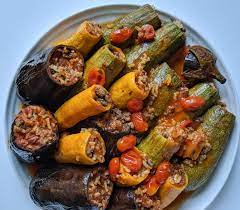Welcome to the culinary journey through Egypt, where every bite is a fusion of rich history and exquisite flavors. In this edition of our blog series on Traditional Egyptian Delicacies, we delve into the world of Mahshi – a delightful dish that encapsulates the essence of Egyptian cuisine. Mahshi, which translates to “stuffed” in Arabic, showcases the country’s commitment to vibrant ingredients and intricate preparation methods.
The Origin of Mahshi:
Mahshi has deep roots in Egyptian culinary traditions, dating back centuries. This dish is a testament to the resourcefulness of Egyptian cooks who found a way to turn everyday vegetables into a savory masterpiece. Stuffed vegetables are a staple in Egyptian households and are often served during festive occasions and family gatherings.
A Tapestry of Flavors: Unveiling the Diverse Variations
The beauty of Mahshi lies in its versatility. While the core concept remains the same, the variations are as diverse as the landscape itself. Each region boasts its own unique interpretation, showcasing local ingredients and culinary traditions. Let’s embark on a journey through some of the most popular variations:
Kousa Mahshi: This classic features tender zucchini, painstakingly hollowed out and filled with a savory rice mixture seasoned with fragrant herbs and spices. The resulting flavor is a symphony of textures – the softness of the zucchini, the fluffy rice, and the delightful crunch of toasted pine nuts.
Wara’ Enab: Delicate grape vine leaves become the canvas for this intricate dish. The filling often boasts a combination of rice, ground meat, and aromatic spices, creating a burst of savory goodness in every bite.
Betinjan Mahshi: Eggplant lovers rejoice! This variation features roasted eggplant, its flesh replaced with a rich and flavorful filling, often featuring lentils, bulgur wheat, and a medley of spices.
Felfel Mahshi: Bell peppers add a touch of sweetness and vibrant color to the Mahshi repertoire. Whether filled with rice and meat or a vegetarian blend of lentils and vegetables, Felfel Mahshi offers a satisfying and flavorful bite.
Beyond the Plate: The Cultural Significance of Mahshi
Mahshi is more than just a dish; it’s a cultural tapestry woven with tradition and family values. It represents the spirit of community and togetherness, as families gather around the table to prepare and savor this culinary masterpiece. The act of preparing Mahshi becomes a bonding experience, passed down from generation to generation, ensuring the survival of this beloved tradition.
The Preparation Process:
Hollowing the Vegetables:
Carefully scoop out the insides of the vegetables, creating a cavity for the stuffing. The size of the vegetables may vary, allowing for a diverse combination of textures and flavors.
Preparing the Stuffing:
Mix the rice with finely chopped tomatoes, onions, and a medley of fresh herbs. The aromatic blend of herbs adds a distinct flavor to the stuffing, while the tomatoes provide a subtle sweetness.
Seasoning:
Enhance the stuffing with a blend of ground cumin, coriander, and paprika. These spices not only infuse the dish with warmth but also contribute to the overall depth of flavor.
Assembling and Cooking:
Gently stuff each vegetable with the rice mixture, ensuring a generous filling. Arrange the stuffed vegetables in a pot, layering them with grape leaves to add an extra layer of flavor.
Slow-cook the Mahshi until the vegetables are tender and the flavors meld together, creating a harmonious blend that is nothing short of culinary magic.
Mahshi stands as a symbol of Egyptian hospitality and culinary prowess, inviting you to savor the unique blend of flavors that characterize this diverse and ancient land. As you embark on your journey with Top Ten Egypt Tours, don’t miss the opportunity to indulge in the rich tapestry of Egyptian cuisine, where every dish tells a story of tradition, innovation, and a passion for good food. Stay tuned for more insights into the enchanting world of Traditional Egyptian Delicacies.



Comment (0)